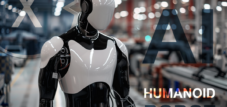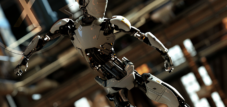Published on: April 7, 2025 / update from: April 7, 2025 - Author: Konrad Wolfenstein

Kawasaki Heavy Industries-Corleo: Futuristic robot horse revolutionizes off-road mobility-Image: Kawasaki Heavy Industries
Kawasaki reveals futuristic hydrogen robots for rough terrain
Corleo: The riding high-tech stimulus of the future
With the “Corleo”, the Japanese technology group Kawasaki Heavy Industries has presented a revolutionary transport concept that makes the boundaries between robotics and means of locomotion blurring. This futuristic vehicle is a hydrogen -powered, four -legged robot that can be ridden like a horse and was specially designed for rough terrain. The concept vehicle presented at Expo 2025 in Osaka combines the latest robot technology with an environmentally friendly drive solution and promises a completely new way of moving away from paved roads.
Suitable for:
- Pioneers of industrial robotics: Kawasaki Robotics-The Hidden Empire of Automation-more than just a factory robot
Technical specifications and drive technology
The heart of the Kawasaki Corleo forms a compact 150 cc hydrogen engine, which acts as a generator. Instead of driving directly wheels, this engine generates electricity, which is forwarded to four electrical drive units - one in each leg in the robot. The hydrogen required for this is carried in a tank at the rear of the vehicle. This hybrid solution made of hydrogen and electricity enables almost noiseless and emission -free operation, in which only water vapor is created as a by -product.
With a shoulder height of 160 centimeters and a length of 170 centimeters, the Corleo is roughly as large as a compact horse. According to information in Japanese media, the vehicle should be able to reach speeds of up to 100 km/h, which is impressive for a vehicle without bikes. The innovative drive concept reflects Kawasaki's commitment to environmentally friendly technologies and fits your vision of a future vehicle for 2050.
The leg mechanics of the Corleo is particularly remarkable: each of the four legs works as an independent unit and ends in a divided “hoof” from non -slip rubber. These two -part rubber pads can adapt various substrates such as rocks, grass, sand or gravel and thus ensure optimal grip on a wide variety of surfaces. The hind legs also have a special suspension system that is reminiscent of the classic motorcycle swing arm and effectively absorbs bumps while walking or running.
Innovative control and AI technology
The Corleo revolutionizes the way vehicles are controlled. Instead of conventional controls, the robot uses a system that monitors and interprets the driver's body movements. The control takes place primarily through weight shift - similar to when a real horse is ridden. Sensors in the stirrups and the handlebars register the movements of the driver and forward this information to the control system.
A particularly advanced element is the integrated artificial intelligence that continuously analyzes the terrain and selects the safest steps. This AI-based regulation automatically adapts the movement of the four legs to the circumstances to ensure safe and liquid propulsion at any time. The system also constantly monitors the balance and stability of the vehicle, registers imbalances and compensates for it, which conveys a trusting driving experience.
For journeys at night, the corleo projects illuminated markings onto the ground to display the path and to facilitate control even in poor lighting conditions. The dashboard shows the driver important information such as the level of the hydrogen tank, the planned route and even the position of the center of gravity in real time.
Design and construction of the robot horse
The design of the Corleo combines elements from Kawasaki's motorcycle division with biomechanical principles. The front section is reminiscent of a motorcycle shield and is equipped with integrated LED lights. The aerodynamically curved and futuristically acting physical disguise underlines the innovative character of the vehicle.
The inspiration for the movement sequences comes from various animals such as wolves, deer and panther. This biomimetic approach enables the Corleo to move like a nature and overcome obstacles that would be insurmountable for conventional vehicles. The robot can not only go and run, but also jump and climb over rocks.
The seat of the corleo is designed for two people and moves independently of the main body, which increases driving comfort. Adjustable stirrups adapt to different body sizes and enable a comfortable seating position. The entire construction is designed to convey a feeling of unity between the driver and machine - Kawasaki speaks of a “calming feeling of unity”.
Kawasaki's legacy in robot technology
The Corleo does not represent the first excursion from Kawasaki into the world of the four-legged robots. The company had already developed a robot in the form of a Capricail goat with the “Bex”, which could also be ridden. This predecessor was able to transport up to 100 kg of weight and was equipped with a handlebar for control.
Kawasaki Heavy Industries has extensive experience both in the field of motorcycle production and in robotics. The company produces various types of industrial robots, including all -purpose robots, collaborative robots, palletry robots and even medical robots. Kawasaki enables these long -term expertise in both areas to develop innovative concepts such as the Corleo that combine the best of both worlds.
In parallel to these futuristic projects, Kawasaki also pursues other innovations in the mobility area. For example, the company plans to conquer the global market with its medical robots and strives to take a similar management position in medical robotics as in the area of industrial robots.
Suitable for:
- Robotics companies: Germany Robotics Top 3 – Leading countries in robotics 2025 – Top 10 Industrial robotics and service robotics

Future vision and practical applications
Although the Corleo is currently still a concept vehicle and the market launch is only planned for around 2050, it shows a fascinating vision for the future of mobility. The combination of terrain, environmental friendliness and intuitive control opens up potential applications in different areas.
The robot could be particularly useful in scenarios in which conventional vehicles reach their limits - for example in the case of rescue operations in difficult to access, research expeditions in rough areas or on ecological exploration tours, where a minimum environmental impact is important. Such a concept could also be interesting for material transport in mountainous or inaccessible terrain, such as for the supply of mountain huts.
The technologies used by Kawasaki in the development of the Corleo-in particular the AI-based control, hydrogen-electro hybrid technology and adaptive leg mechanics-could also flow into other products of the company and thus also lead to innovations at short notice.
Future vision or utopia? The reality test on the Expo 2025
Despite all the enthusiasm for the futuristic concept, there are some challenges that have to be managed before a possible market launch. On the one hand, the hydrogen infrastructure has not yet been expanded across the board, which could restrict the practical use of such a vehicle. On the other hand, the production costs of such a complex robot are likely to be significant, which raises questions about the economy and accessibility for the average consumer.
What was shown at Expo 2025 in Osaka is first a mock-up-a model that illustrates the concept but does not yet have all functional properties of the desired end product. The actual technical feasibility in the intended form still has to prove, and it remains to be seen whether and how Kawasaki can realize the ambitious vision by 2050.
Revolution of off-road mobility
The Kawasaki Corleo represents a courageous look into the future of locomotion and shows how the boundaries between vehicle technology, robotics and biomechanics can blur. With its innovative hydrogen drive, AI-based control and animal-like movement ability, it represents a vision that goes far beyond conventional means of transport.
Although it is still a long way to the possible market launch, the Corleo is already demonstrating Kawasaki's innovative strength and willingness to develop unconventional solutions for the mobility challenges of the future. Regardless of whether this specific concept ever goes into series production, the technologies and ideas developed will certainly influence the development of future means of transport.
Kawasaki's futuristic robot reminds us that the future of mobility is not only due to the improvement of existing concepts, but also in exploring completely new approaches that could fundamentally change our idea of how we can move.
Suitable for:
Your global marketing and business development partner
☑️ Our business language is English or German
☑️ NEW: Correspondence in your national language!
I would be happy to serve you and my team as a personal advisor.
You can contact me by filling out the contact form or simply call me on +49 89 89 674 804 (Munich) . My email address is: wolfenstein ∂ xpert.digital
I'm looking forward to our joint project.












